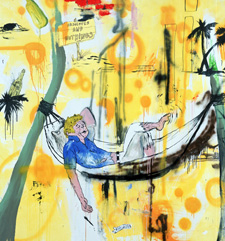Since the late 1980s, Los Angeles-based painter Thaddeus Strode has created wild, vibrantly colored mash-ups in which California surf and skateboard culture collide with Zen philosophy, rock music, literature, film, comic books and other popular motifs, all mixing freely with the artist’s own inventions.

Beginning Feb. 8, the Mildred Lane Kemper Art Museum will present the first major museum exhibition dedicated to Strode’s work as part of its Contemporary Projects series. Organized by Sabine Eckmann, Ph.D., director and chief curator of the Kemper Art Museum, and Meredith Malone, Ph.D., assistant curator, “Thaddeus Strode: Absolutes and Nothings” will feature more than two dozen large-scale mixed-media paintings created over the past eight years.
Strode’s work represents a provocative strain within contemporary painting, one that expresses, among other things, a strong penchant for dark humor and the absurd. Much of the strength and visual pleasure of Strode’s aesthetic comes from his self-reflexive combination of painterly styles and preposterous elements, allowing enigmatic texts, phantoms, monsters and castaways to play off one another to produce cryptic — and captivating — fantasy worlds.
For example, “Under the Killing Moon (… Spilling and Spilling … There Was a Point Where No One Resisted)” (2004) depicts a large pale toad perched amidst a dark skyscape of floating orbs, keyboard letters and truncated phrases. The title, meanwhile, alludes to the classic 1984 post-punk anthem by Echo and the Bunnymen, adding yet another layer of meaning to this potent scene.
Strode’s compositions seldom convey specific themes or fixed ideas but are filled with contradictions and incoherencies that play with viewers’ expectations while merging modes and styles historically viewed as oppositional — abstraction versus figuration, the expressive versus the rational. Unlike pop or various instances of appropriation art, which directly incorporate recognizable imagery from mass media and everyday life, Strode’s canvases contain fragments that appear familiar yet somehow thwart the viewer’s ability to pinpoint definitive sources.
One striking example is “Come out Screaming (American Dreams)” (2006), in which a hillbilly-like cartoon figure marches through geometric abstractions as well as loose, painterly drips and splashes.
Another key aspect of Strode’s work is the diverse and constantly evolving cast of characters — gorillas and castaways, ghosts and monsters — that demonstrate his interest both in the grotesque and in transitional states of being.
For example, the castaway in Strode’s “Absolutes and Nothings” (2001), from which the exhibition’s title is derived, is an instantly recognizable metaphor for alienation and detachment from mainstream society. Here depicted in a state of limbo, the figure exists somewhere between civilization and island primitivism, thus revealing the artist’s heightened sense of the incongruous, the sinister and the bizarre.
Born in 1964 in Santa Monica, Calif., Strode studied at the Otis/Parsons Art Institute and the California Institute of the Arts, earning a bachelor of fine arts degree from the latter in 1986. His work has been exhibited across the United States and internationally and is displayed in public and private collections worldwide. He lives and works in Los Angeles.
“Absolutes and Nothings” will be accompanied by a full-color illustrated catalog. The book will contain essays by Eckmann and Malone as well as a provocative piece of short fiction by the author and visual artist Benjamin Weissman.
Support for the exhibition was provided by James M. Kemper Jr.; the David Woods Kemper Memorial Foundation; the Hortense Lewin Art Fund; and museum members.
The exhibit will open with a reception at 7 p.m. Feb. 8 in the Mildred Lane Kemper Art Museum’s Barney A. Ebsworth Gallery and remain on view through April 21. As part of the reception, Strode will host a walk-through of the exhibition with the curators at 7:30 p.m.
The reception, exhibition and walk-through all are free and open to the public. For more information, call 935-4523 or visit kemperartmuseum.wustl.edu.